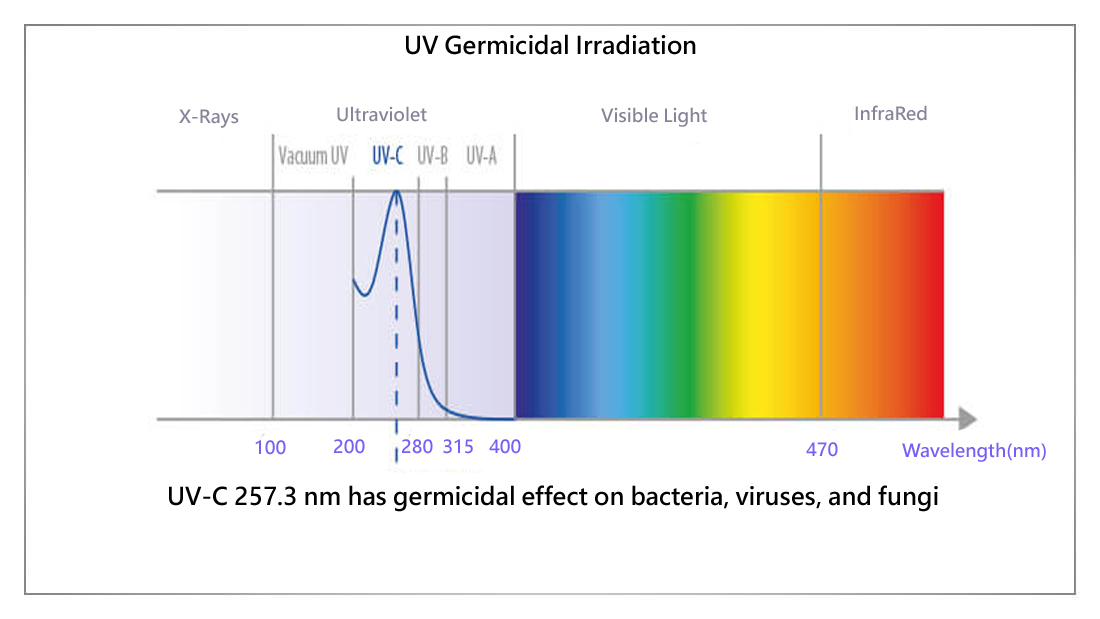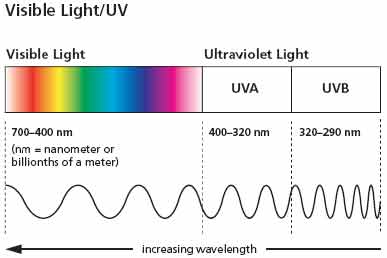
Uva uvb uvc wavelength skin#
In part, since it penetrates so deeply into the skin’s layers, this kind of radiation is responsible for skin aging symptoms such as spots and wrinkles (through to the dermis layer). UVA radiation has the longest wavelength and penetrates the deepest into the earth’s atmosphere, accounting for the great majority (up to 95 percent) of UV light that passes through the atmosphere. UVB rays do, in fact, age the skin over time. Skin cancer is strongly associated with ultraviolet B (UVB) radiation. It is dependent on the time of day and season whether UVB rays are stronger or weaker. It may cause damage to your skin’s top layer (epidermis) after as little as 15 minutes of exposure to the sun. It is mostly absorbed by the ozone layer, but some of it still makes it through (about 5 percent gets through overall). UVB radiation has the second shortest wavelength of all and is the primary cause of sunburn. After we define UVA and UVB, we’ll go into further detail about this. As a result, individuals who should be worried about UVC radiation are those who operate with man-made sources of UVC radiation, such as welding torches, mercury lamps, and, you got it, germicidal UV-C illumination, which we provide. Despite the fact that naturally occurring UVC radiation does not infiltrate the earth’s atmosphere, inorganic sources of UVC radiation do exist and may be hazardous if not handled correctly. This is not to suggest that ultraviolet C is not hazardous. The ozone layer totally absorbs ultraviolet C radiation. Remember that they do not even naturally enter the earth’s atmosphere at all, as previously stated. Consequently, although UVC is the most damaging since it has the shortest wavelength, it poses little threat to the average person because the sun’s natural UVC emissions do not penetrate the skin. UVC, on the other hand, is unable to penetrate the earth’s atmosphere, which is fortunate for humans. The shorter the wavelength of UV light, the more hazardous it is to the skin. UVC has the shortest wavelength of the three types of ultraviolet radiation. Take Care of Yourself and Use sunscreen to protect your skin.(UVA rays can reflect off snow or ice.)įor more tips, visit our UV index page to better understand the UV index chart and the meaning behind the different sun exposure ratings. Remember to be cautious even during the winter months for UVA rays and stay protected when skiing or snowboarding. Use sunscreen for the hottest parts of the day (10 am - 4 pm.)Ģ. Choose a UPF 50 hat or clothing to keep your skin safe and protected from harmful UV rays. Here are a few tips to staying protected:ġ. It is vital to make sure that your skin is protected whether it be summer or winter, day or even night. They are able to bounce off reflective surfaces such as water, including liquid and ice or snow. UVA rays are present all year round and in all seasons. They are not the number one culprit but can cause changes in DNA, which eventually can lead to skin cancer. They reach deep into the skin and are the predominant cause of aging, wrinkling, loose skin, and sunspots. UVA rays permeate into the skin the deepest of the 3 different rays. The most important times to stay protected are during the spring and summer months between the hours of 10 am and 4 pm. These rays can cause changes in DNA in cells directly and be one of the top culprits to skin cancer. It is the most prevalent cause of the redness, sun burning, and skin cancer. UVB rays reach past the ozone layer to the superficial layers of our skin. They usually aren't destructive on our skin. UVC rays are actually the strongest but are mostly absorbed by the atmospheric ozone. UVC is the shortest and not long enough to reach our skin UVB rays come in contact with the outer layer of the skin UVA radiation penetrates deeper into the skin, all the way into the inner layers. UV wavelengths vary in size and differ in how they affect our skin. UV rays are broken down into 3 different bands: UVA, UVB, and UVC.
Uva uvb uvc wavelength how to#
Here's exactly what you need to know about UV radiation, how it affects us, and how to keep your skin safe!


These effects show up over time when our skin is not protected. The problem occurs when UV rays frequently come in contact with our skin its effects can be long term and detrimental. In small doses, it actually helps us to produce vitamin D that our bodies need.


 0 kommentar(er)
0 kommentar(er)
